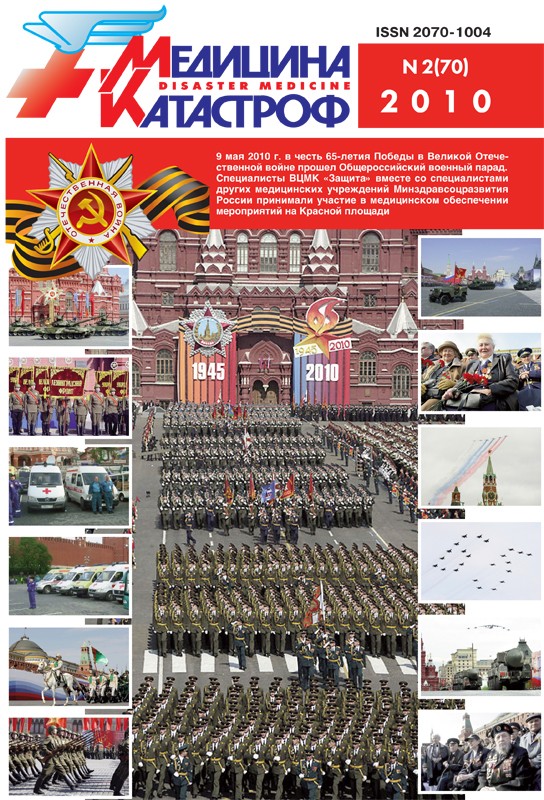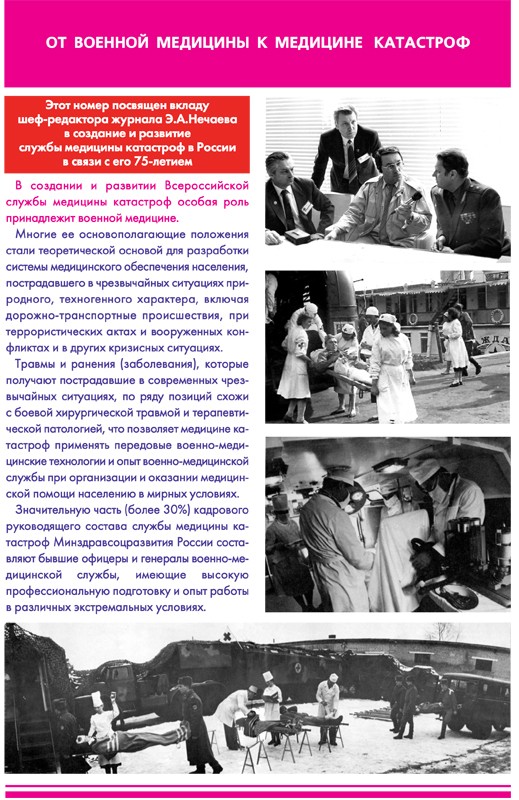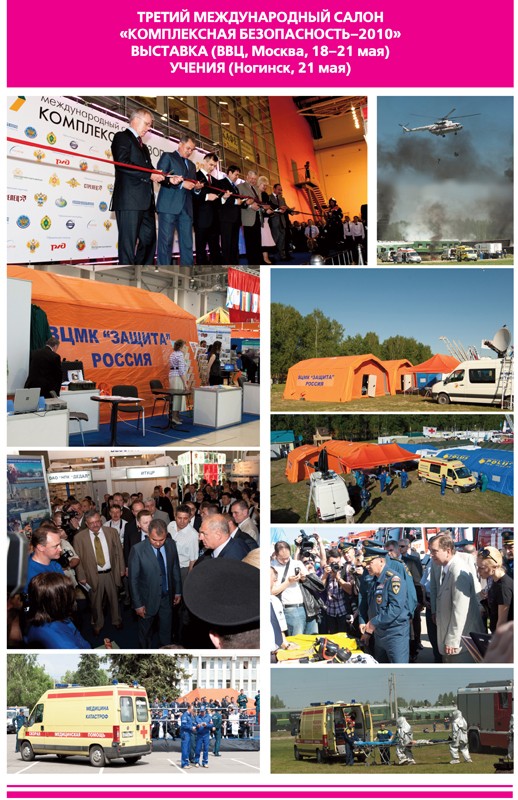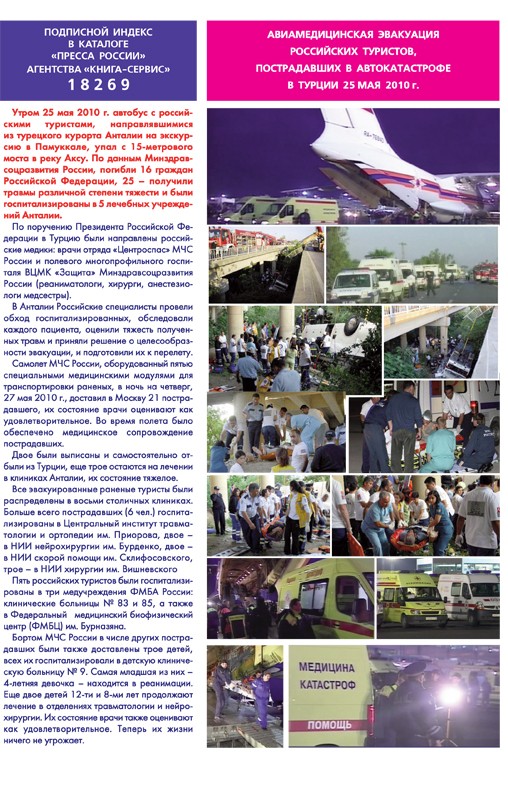ORGANIZATION AND TACTICS OF DISASTER MEDICINE SERVICE
1. Fyodorov V.D. History of Creation of Disaster Medicine Service in Russia
The stages of development of the disaster medicine service in Russia are presented. The organization and management of medical care rendering to victims of Armenia earthquake (1988), of Bashkiria railway explosion (1989) and of Perm fire (2009) are analyzed.
Key words: Armenia earthquake, Bashkiria railway explosion, casualty evacuation, disaster medicine service, mass casualties
2. Goncharov S.F., Bobiy B.V. All-Russian Service for Disaster Medicine : Results of Activity and Development Prospects
The history of creation of All-Russian Service for Disaster Medicine (ARSDM) as a branch of health service, its structure and functioning on federal, inter-regional, regional, municipal and facility levels are presented. The role and place are shown of All-Russian Center for Disaster Medicine «Zaschita» in scientific research work on disaster medicine issues, in education and training of necessary personnel and in liquidation of medical and sanitary consequences of emergency situations in the country and abroad.
The reasons are stated why further improvements are needed of the structure and functioning of ARSDM in the field of medical care of population of the country in emergency situations of natural and technological origin and of acts of terror and armed conflicts.
Key words: disaster medicine as an element of general security, directions of development, disaster medicine organizational structure, emergency situations menace, medical care of population
3. Chizh I.M. Military Medicine and Disaster Medicine
The substance of the notions “military medicine” and “disaster medicine” is considered. The experience of medical support of troops during the Great Patriotic war and local wars and armed conflicts of the second half of XX century is analyzed. The experience is presented of military-medical formations’ part in liquidation of medical and sanitary consequences of peace-time emergency situations. The conclusion is drawn that the concept of disaster medicine elaborated on the basis of the essential issues of military medicine field doctrine is not only the foundation of the All-Russian Disaster Medicine Service but is the model of use of military-medical formations in military conflicts of different intensity.
Key words: disaster medicine, emergency situations, Great Patriotic war, local wars and armed conflicts, special purpose medical teams, step-wise treatment of sick and wounded
4. Bryusov P.G. Disaster Medicine and Military Field Surgery
The principles of organization and management of rendering of surgical care to casualties of emergency situations based on the achievements of military field surgery are presented. The features distinguishing disaster medicine from military medicine are presented. The major premises of surgery doctrine of disaster medicine suggested by the contribution author in 1991 are considered. A retrospective analysis is done of organization and management of medical care rendering to casualties of peace-time disasters and of local armed conflicts in the Northern Caucasus (1994–1996, 1999–2000) and South Ossetia in 2008.
The experience-based conclusion on the validity and the well-founded nature of the suggested doctrine premises are drawn. The premises were assimilated and approved by the practical activity of the disaster medicine service.
Key words: disaster medicine, emergency situations, field multiprofile hospital, military field surgery, qualified surgical care
5. Cheplyaev A.A., Shabanov V.Eh. Experience of Field Multiprofile Hospital in Medical Care Rendering to Population in Armed Conflict Environment
Information on the activity of field multiprofile hospitals in the Chechen Republic in 1994–1996 and 2000–2002, in the Republic of Ingushetia in 2000-2002 and in South Ossetia in 2008 is presented.
Key words: aeromobile hospital of Emergency Ministry, armed conflict, counter-terrorism operation, field multiprofile hospital, field pediatric hospital, field therapeutic hospital, field tuberculosis hospital, the Chechen Republic, the Republic of Ingushetia, the Republic of South Ossetia
6. Starodubov V.I., Son I.M., Pikhotsky A.N. Formation and Development of Compulsory Medical Insurance System in Russia
The analysis is done of present-day systems of compulsory medical insurance (CMI) of Russia and of some leading countries of the world. The shortcomings and advantages of tax-financed model of health insurance are shown. The actual problems of health system financing are revealed. The contemporary regulatory and legal framework is analyzed as well as the specific features of the interaction between insurance subjects. The quantitative evaluation of the rates of CMI in 2005–2009 is done and CMI and paid medical service market capacity is assessed. Some problems of the interaction between subjects of insurance business on regional level are revealed.
Key words: compulsory medical insurance, health insurance institutions, legal framework of insurance business in health sphere, medical and economic standards, medical care financing, medical services rates, voluntary medical insurance
7. Bukhtiyarov I.V., Sobolenko A.K., Murashov N.V., Medvedev V.R., Sidorov V.A., Kayumova L.I. Mobile Medical Complexes: Past, Present, Future
The changes in combat operations character requires new approaches to medical support of troops and new facilities of medical service, mobile medical complexes being a part of the facilities. The history of the development of complexes, experience of their practical use in battle environment and work on their modernization are covered in the article. A description of some adopted and of some advanced new generation models is given as well.
Key words: medical formations, medical support of troops, experience of use of mobile medical complexes, mobile medical complexes, troop-level medical service structures
CLINICAL ASPECTS OF DISASTER MEDICINE
8. Nechaev Eh.A., Minnullin I.P., Fomin N.F. Blast Injuries – Global Issue Facing Humanity
The statistic data proving the global character of mine problem are provided and the importance of scientific research of blast injuries is stressed. The particular contribution of Russia’s scientists and doctors in research work and in elaboration of practical recommendations in the field is noted.
Key words: blast casualties, blast injuries, experience of blast injuries treatment, medical support of troops, mine problem, terrorism
9. Savitsky G.G. Surgical Treatment of Casualties with Crush Syndrome
Recommendations on surgical treatment of casualties with crush syndrome are presented. The principal surgical interventions in the cases are considered. The role of Eh.A.Nechaev in scientific rationalization and practical use of the recommendations is noted.
Key words: amputation, casualties, crash syndrome, fasciotomy, necrectomy, surgical care
10. Potapov A.A., Likhterman L.B., Kravchuk A.D., Kornienko V.N., Zakharova N.E., Loshakov V.A., Kostanyan V.Zh. Craniocerebral Trauma: Scientific and Applied Aspects
The results of study of craniocerebral traumas caused by explosion are presented. Characteristics of direct primary blast injuries of brain are given. The specific form of craniocerebral trauma – cranial crush injury – is described in detail.
Key words: blast trauma, craniocerebral traumas, evidence based medicine, head crush injuries, traumatic brain injuries
11. Voinovsky E.A., Kovalyov A.S., Kukunchikov A.A., Voinovsky A.E., Shabalin A.Yu., Koltovich A.P. Surgical Management of Casualties with Leading Abdominal and Pelvic Severe Multitraumas
An analysis is done of treatment results of 235 casualties with severe multitraumas and combined blast traumas who received qualified medical care at special purpose medical team of the Main Military Hospital of Internal Troops of Home Affairs Ministry of Russia in the territory of North Caucasus and at Medical Battalion 357 in 1994–1997 and 1999–2006.
From the total number of the casualties 102 patients (43.4%) had abdominal wounds and 40 (17.0%) – pelvic wounds, and in 46 cases (19.6%) those traumas were the leading injuries. In 16 casualties (34.8%) the tactic of stage damage control was used. Early post surgery complications were in 11 cases (23.9%), one patient died (2.2%).
Key words: abdomen, casualties, pelvis, severe multitraumas, surgery tactics, surgical treatment
12. Zubritsky V.F., Zabelin M.V., Yudin A.B., Pokrovsky K.A., Bragin A.G. Abdominal Compartment Syndrome in Patients with Closed Abdominal Injuries
The results are presented of measurement of intra-abdominal tension dynamics in 84 casualties with closed abdominal injuries. It is found that intra abdominal hypertension was present in 58.33% of the closed abdominal injury cases. The assessment of intra abdominal tension dynamics depending on surgery modality is done. A statistically significant correlation between the intra-abdominal tension and the frequency of pathogeny of polyorgan deficiency and status severity is revealed.
Key words: abdominal compartment syndrome, casualties with closed abdominal injuries, intra-abdominal tension, polyorgan deficiency
13. Granov A.M., Rosenberg O.A. Surfactant in Treatment of Noncardiogenic Pulmonary Edema in Emergency Casualties
In the article the authors show the contribution of Eh.A.Nechaev to the solution of organizational and clinical issues connected with development and introduction into clinical practice of home-made lung surfactant preparation. They note that the experience of clinical use has proved high efficiency of the preparation in treatment of respiratory distress syndrome, especially in newborns. They support the statement with research and results of their own. They quote publications of Russian as well as of foreign researchers.
Key words: сlinical trials, respiratory distress syndrome, Surfactant-BL, syndrome of acute lung injury
14. Kovalyov A.S., Smirnov S.V., Loych I.B., Voynovsky A.E., Menzul V.A., Koltovich A.P., Il’in V.A., Ekamasova E.A., Barkalev M.A. Topical Treatment of Burn Wounds in Wound Fluids
The results are studied of 167 cases with burns covering from 3 to 72% of the body surface. The topical treatment of the wounds was carried out in wound fluids with application of film bandages “DDB-M” and “Breimenderm”. This method of complex treatment of burns allows to cut the duration of preoperative preparation and the length of hospital stay and to reduce the frequency of postoperative complications as well as to improve functional and cosmetic results of the treatment.
Key words: burns, film bandages, local treatment, wound fluids
15. Aleksanin S.S., Shapovalov S.G., Belykh A.N. Specifics of Organization of Medical Aid and Treatment of Burn Casualties in Counter-Terrorism Operation in Chechen Republic
Specifics of organization of medical aid and treatment of burn casualties in counter-terrorism operation in Chechen Republic in 1999–2001 are presented.
From the analysis done the following major conclusions are drawn: the medical care of burn casualties in local wars and armed conflicts must be based on a two-stage procedure – after medical first aid burn casualties must be transferred directly to skilled/specialty medical care stage. The efficiency of treatment of such patients directly depends on the speed of their evacuation from combat zone.
Key words: counter-terrorism operation in Chechen Republic, burn casualties, emergency situations, organization, stages of medical care, treatment
MEDICAL ASPECTS OF ROAD TRAFFIC SAFETY
16. Rosinov V.M., Goncharov S.F., Makarov I.A., Suvorov S.G., Potapov V.I., Yazelskaya L.V., Divilina Yu.V. System of Organization and Delivery of Specialty Emergency Medical Care to Pediatric Traffic Accident Casualties
The results are presented of realization of a pilot project that concerns the improvement of the system of organization and delivery of specialty emergency medical care to pediatric traffic accident casualties in Moscow Oblast. It is noted that the bulk of forces and facilities of the project are provided by medical institutions and formations of the All Russian Service for Disaster Medicine. A large volume of data substantiating the efficiency of the system is presented. A conclusion is drawn that the system in action in Moscow Oblast can serve as a model for treatment and evacuation process in other regions with developed motorway networks.
Key words: All Russian Service for Disaster Medicine, children, Moscow Oblast, road traffic accidents, specialty emergency medical care
INTERNATIONAL COOPERATION
17. Kipor G.V., Goncharov S.F. NATO Joint Medical Committee: Strategy and Directions of Activities
The place of the Joint Medical Committee within the structure of NATO Civil Emergency Planning Directorate under present-day conditions, the main directions of medical strategy and the mechanisms of support of functioning of experts in different fields of Committee’s activities are given consideration. The performance of the Committee is judged from the angle of its contribution to the improvement of response system to emergency situations.
Key words: civil emergency planning, Committee of the Chiefs of Military Medical Services in NATO (COMEDS), Euro-Atlantic Partnership Council, Joint Medical Committee, NATO experts, NATO rapid response teams




